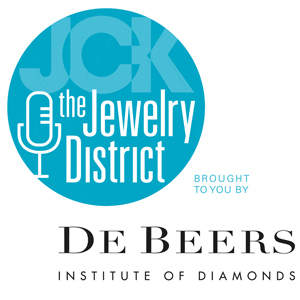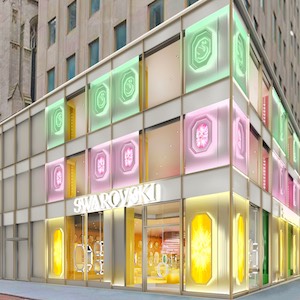
JCK editor-in-chief Victoria Gomelsky and news director Rob Bates share news from their recent trips to Geneva and Austin to attend key industry conferences. At Geneva’s Watches and Wonders, Victoria noted a trend toward red and burgundy watch accents. She also saw a preponderance of derivative designs rather than radical innovations, and she theorizes about the reason for that. Rob reports that at a well-attended AGS Conclave in the Texas capital, lab-grown diamonds and gold prices were hot topics, and he got a fascinating behind-the-scenes tour of a local boutique lab-grown producer.
Listen Now
Sponsored by De Beers: institute.debeers.com
Show Notes:
03:43 From Geneva: seeing red and lingering pandemic effects
11:16 Crowds and cautious optimism at AGS Conclave
15:40 Inside a boutique lab-grown diamond facility
Episode Credits
Hosts: Rob Bates and Victoria Gomelsky
Producer and engineer: Natalie Chomet
Editor: Riley McCaskill
Plugs: @jckmagazine; institute.debeers.com
Show Recap
From Geneva: seeing red and lingering pandemic effects
Victoria tells listeners about her recent trip to Switzerland for Watches and Wonders. The trade show, formerly SIHH, dates from the 1990s, when a small group of exhibitors founded it as a satellite event to Baselworld. With the disappearance of Baselworld, a lot of brands joined Watches and Wonders, and today the fair has become “quite a nexus of high-end watchmakers,” Victoria says.
Rob points out that Swatch was conspicuously absent. “That’s a big miss,” Victoria agrees, adding that a collector she spoke with mentioned the brand’s nonattendance. It seems a lost opportunity, given the fact that Swatch Group hasn’t come up with an alternative way to showcase its new offerings to press and editors, she says.
With strong attendance and satellite events, “the show was very busy,” and in terms of seeing friends and meeting new contacts, it was great, Victoria says. Product-wise, on the other hand, “it was a little underwhelming. It was a year where we saw a lot of iterative designs.” The main novelties were added complications to existing models and new color variations. “There were a lot of red dials and burgundy accents, a very bold color for the Swiss,” she says. “We also saw a lot of greens and blues.”
Victoria suspects the lack of innovation stems from the fact that the industry is now seeing designs that were conceptualized in 2020 and 2021—a time when companies were working by Zoom. “You get the best ideas when you’re with your team working face-to-face,” she says. Now that creative teams are back in the office, bolder looks may come to the fore in the next few years. “I think the long tail of what the pandemic did to design is a really interesting conversation,” she says.
Crowds and cautious optimism at AGS Conclave
Just back from the American Gem Society Conclave, Rob reports that industry members were there in full force and the mood in Austin was cautiously upbeat. “There were 800 attendees, the most in 15 years,” he notes.
“People are nervous about the gold price, and there was a lot talk about lab-grown,” he says. The show doesn’t draw a pro-lab-grown group, he says, though a number of retailers told him they feel compelled to carry the product because people ask for it.
Overall, retailers’ business seems to be on par with 2023 based on the feedback he got. “During the pandemic, everybody’s business was up. During the great financial crisis, everybody’s business was down. Now we’re in a more traditional pattern,” he says, where some retailers excel while others’ sales decrease.
Changes are on the horizon for Conclave: Next year’s event—named Converge—will be a joint AGS and GIA symposium in Carlsbad, Calif., in September. This larger show will replace the traditional Conclave.
Inside a boutique lab-grown diamond facility
Among the highlights of Rob’s time in Austin was a visit to a lab-grown facility run by boutique maker Plasmability. Their factory was small—far removed from the “football fields with rows and rows of machines” that Rob says he’d heard some lab-grown-diamond manufacturers maintain in India.
The company was security-conscious and protective of its process, prohibiting photos and requiring cellphones to be placed in zippered bags. “They have what they consider an original process,” Rob says. The staff explained that their diamonds are grown in one uninterrupted process, which takes longer than the industry standard but produces a higher-quality stone commanding a higher price tag. “When we left, they gave us a piece of rough. It really shows the difference in the value proposition. If you left a mine with a decent-sized piece of rough, you would probably get arrested.”
Victoria asks what Rob’s take-home lab-grown rough looked like. “I expected it to be a scientific orange cube, but it wasn’t,” he says. “It didn’t look exactly like a piece of [mined] rough, but it was close. Surprisingly so.”
Since many on the Plasmability team come from a tech background, Rob asked the head of the company to weigh in on widespread speculation that lab-grown diamonds will someday soon be ubiquitous in the manufacture of cellphones and even semiconductors. The answer? Predictions are overblown. “He said he thinks that’s many years away,” Rob says.
All in all, Rob believes the factory tour gave people a positive impression of Plasmability, and he hopes more lab-grown companies will follow the company’s lead. “It definitely gives you a certain respect for the technology required to produce the product,” he says.
Any views expressed in this podcast do not reflect the opinion of JCK, its management, or its advertisers.
- Subscribe to the JCK News Daily
- Subscribe to the JCK Special Report
- Follow JCK on Instagram: @jckmagazine
- Follow JCK on X: @jckmagazine
- Follow JCK on Facebook: @jckmagazine





